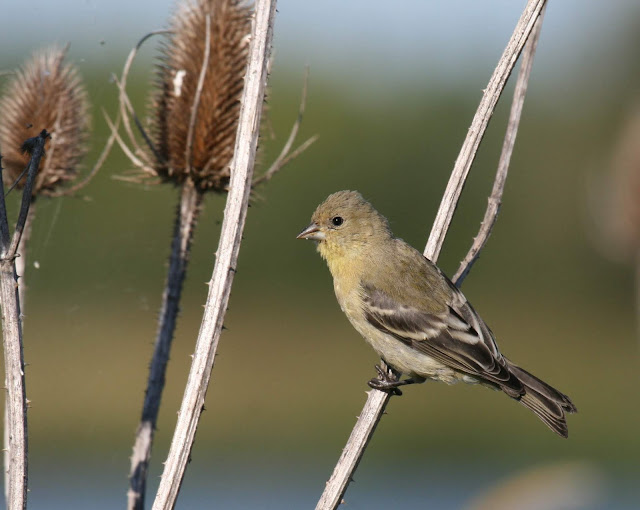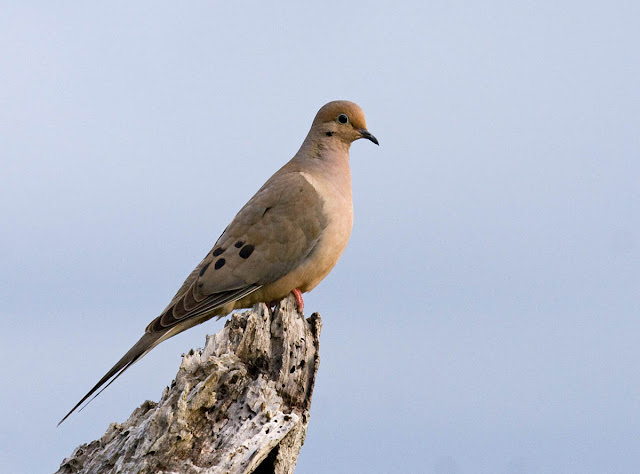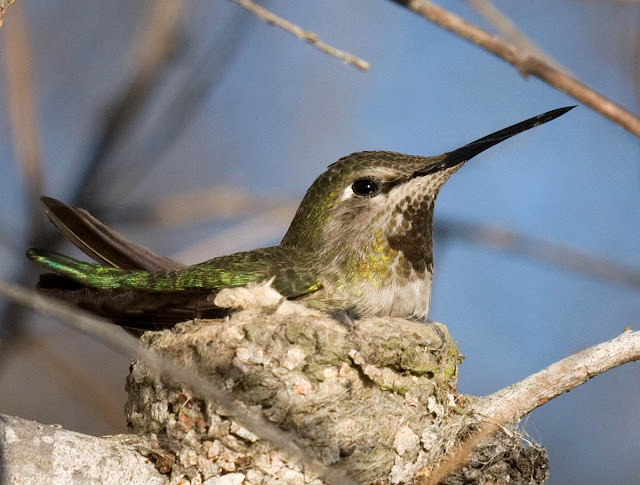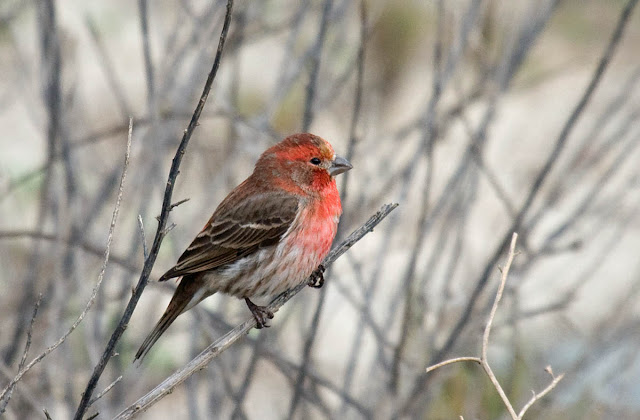The following 10 species of backyard birds are the most frequent in the San Diego region. In fact, these 10 would be common backyard birds nearly anywhere in California away from mountains and driest deserts. From Redding south to Bakersfield, and San Francisco south to San Diego, it might be difficult to find a residential backyard where all these birds do not occur, year-round.
These birds, then, would certainly serve as an introduction to backyard bird watching in California.
Can you spot these 10 in
your backyard? Which one is your favorite?
1) Lesser Goldfinch
 |
| Male Lesser Goldfinch. Fallbrook, California. May 4, 2014. |
 |
| Female Lesser Goldfinch. Forest Grove, Oregon. August 28, 2007. |
The tiny Lesser Goldfinches like weedy fields with oak savannas where they eat small seeds. To attract them to your yard, hang up a "thistle sock" stocked with Nyjer seed.
2) House Finch
|
|
| Male House Finch. Imperial Beach, California. January 30, 2016. |
 |
| Female House Finch. Escondido, California. June 20, 2018. |
House Finches are found in residential areas and farms with scattered trees. To attract them to your yard put up a tube feeder with black oil sunflower seeds.
3) Mourning Dove
 |
| Mourning Dove. Solana Beach, California. May 17, 2017. |
Mourning Doves are birds of open residential and farmlands. To attract them to your yard feed sunflowers, cracked corn on a tray feeder. They nest in covered corners--carport beams, on porch lights, etc. Listen for their mournful crying song (boo, hoo-hoo) on spring mornings.
4) Anna's Hummingbird
 |
| Male Anna's Hummingbird. Rancho Bernardo, California. January 21, 2018. |
 |
| Female Anna's Hummingbird on nest. Cardiff, California. February 1, 2016. |
These pugnacious little sprites love flowering plants and small insects. To attract them to your yard plant flowers and hang a hummingbird feeder with 4 parts water to 1 part table sugar. They nest very early, late December to March).
5) Northern Mockingbird
 |
| Northern Mockingbird. Borrego Springs, California. January 7, 2018. |
Mockingbirds hang out in residential areas with large dense shrubs. They eat insects and berries. They'll sing from telephone lines and low trees, nearly non-stop, day-and-night, all year long.
6) California Scrub-Jay
 |
| California Scrub-Jay. Hillsboro, Oregon. April 21, 2010. |
Jays are bold and brash and eat animals and vegetables as food. Because they are large and take lots of food away from the feeder to hide it for later (called caching), you may not want too many Scrub-Jays in your backyard. If you have an older field guide you may find this bird listed as Western Scrub-Jay.
7) American Crow
 |
| American Crow. Newport, Oregon. April 20, 2008. |
Frequently found in cities, crows are smart enough to get into nearly any kind of trash container to find human food scraps. In residential areas they may only visit during the day, flying off at dusk to roost in the hundreds in orchards or other dense patch of trees. They frequently gang up on hawks and owls, making a noisy mob.
8) Black Phoebe
 |
| Black Phoebe. San Diego, California. May 10, 2015. |
Frequenting quiet ponds and wet places, large expanses of grass lawns make a great substitute for this flycatcher that feeds on low-flying insect. Their sweet chip note, bobbing tail, and unfearing nature makes them a favorite backyard bird.
9) California Towhee
 |
| California Towhee. Poway, California. April 8, 2018. |
This large sparrow is rather plain brown. It will feed on sunflower seeds on a tray feeder or, more likely, on the ground under it. They hide under bushes in residential areas, kicking leaves with both feet to see what's under them. When they do this in your feeder they can scatter seed everywhere!
10) Western Bluebird
 |
| Male Western Bluebird. Beaverton, Oregon. March 9, 2013. |
 |
| Female Western Bluebird. Santee, California. October 11, 2013. |
While they might be more abundant in an open oak woodland, Western Bluebirds don't mind putting up with residential human activities if there is an expanse of lawn or pasture they can search nearby for bugs. They also need a gnarled tree with a cavity to use as a nest. Placing a nest box on your property may make it more enticing, if there is ample lawn nearby.
Want more? Here are
Another 10 common backyard birds of San Diego.
And...
A Final 10 common backyard birds of San Diego.















How did you determine the top 10? I'm surprised that song sparrow is not in the top 10.
ReplyDeleteThanks for your feedback,Tito.
ReplyDeleteIn such a list it is always a challenge in what to include and what to exclude.
Thus you may be happy to know that I have a future post with more backyard birds, including Song Sparrow!
Let's see here - we've seen 7 of the 10 from our yard which is in the redwoods of Northern California. We are missing Lesser Goldfinch, Northern Mockingbird and Western Bluebird.
ReplyDeleteWe've watched a flyover of Western Bluebirds about a mile away from our house while out on a walk, but we've never noticed LEGOs or NOMOs in our neighborhood.
Yes, I would guess those 3 a little bit harder in NW California. I would have thought maybe the jay, too. Or the jay rather than the mockingbird.
DeleteYeah, Steller's outnumber the Scrubbers by a good margin. But a single scrub-jay seems to have moved in to our neighborhood last fall. I'll be interested to see if they stay through spring/summer.
DeleteCan you tell me if goldfinches migrate at this time of year? I've noticed fewer on my nyjer thistle feeders the last month or so. There used to be lots of them. There are still a few, but not like a month ago.
ReplyDeleteGood question, Connie! Rather than migrating, birds are paired up now, laying eggs, raising young, and defending territories from each other, not as sociable as other seasons. Soon they'll be back bringing their youngsters to your feeder!
DeleteI live in Chula Vista. Besides all of the above, this time of year I have seen (and heard) bright yellow orioles and woodpeckers in and around our coral tree. I have seen a robin or two in our nearby pines. In our nearby small lake, 3 Canadian geese (1 pair, 1 bachelor) are staying for the summer. Now and then, a pair of big white pelicans stops by for a week or two. We had an abundance of gnats last year, which attracted many swallows. A few this year also. Occasionally, some egrets and a large blue heron will stop by the lake as well. We also have lots of mallards and coots year-round. Lots of birds in our neighborhood!
ReplyDeleteWhat a wonderful neighborhood for birds, Pam! Thanks for sharing.
DeleteWhat a wife array of birds you are privy to observe. It absolutely amazes me just how many species are interdependent upon each other and the environment. Thanks for sharing your experiences with us
DeleteThats awesome!!
DeleteWe have a black and yellow bird it’s building a nest under a large fan palm it hangs upside down the nest is long strings
DeleteThanks for sharing this list. It’s the black phoebes that have my heart. Their plump round bodies are so cute and they are attempting to rid us of yucky insects! I named the one who waits patiently on a retaining wall for his lunch to fly by, Mark Wallberd. Question, today a lovely gold bird game to feed at my hummingbird feeder. I am still new to identifying birds. I guessed him to be an oriole but just learning and seeing goldfinches raid hummingbird nectar too. I’m wondering the best way to tell my yellow birds apart. I believe his mate waited very close to him on a giant sunflower leaf.
ReplyDeleteYes, SaharaViolet, orioles will drink from hummingbird feeders. In Southern California we have Hooded Orioles and Bullock's Orioles.
DeleteCan you help Id this bird? It perched briefly in a tree next to me in El cajon at first light today, 2/21/2020. It sat upright like a small falcon with its tail vertical. Tail feathers narrow and square when perched. Compact body, perhaps pigeon sized,o a little smaller. Light colored head, with a short curved bill like a small falcon or owl. It chirped loudly several times before it flew. Too dark to see other colors except top of tail was visible when it flew, striped lengthwise like a mockingbird - white-dark-white. I'd guess about 12-18" wingspan and 8" perched height. But for the striped tail I might have called it a Merlin.
ReplyDeleteThe dark tail with white outer tail feathers certainly does sound like a mockingbird. There aren't any hawks with that pattern. It's early for Western Kingbird, and that bird has a larger flat flycatcher bill.
DeleteAmerican Kestrel is more common than Merlin. But it has a darker head and tail doesn't match. Though it does have a "killy-killy" call.
Parakeets and parrots give loud chirps or shrieking calls. Parakeets have long pointed tails, parrots have very short square tails. Again, nothing matches the tail as you described.
I'm stumped!
Thanks for reading!
The most common in my area (Vista) are these Grackles
ReplyDeleteThanks for taking the time to stop by and say hi, Ratin. Have you been up to Buddy Todd Park? It's not far, I don't think, maybe more Oceanside city limits than Vista. It always has great birds but is especially good in spring and fall for migrants.
DeleteI love seeing the Black Phoebes in our backyard. They must have excellent eyesight because they find every critter in my lawn.
DeleteI love grackles (I know I'm probably in the minority, but I think they're great)! I've never seen one here, though - only in Texas. I'll have to be on the lookout.
DeleteJust this morning, I was entertained by a big bossy scrub jay, a flock of bluebirds, a flock of scrappy goldfinches, a couple housefinches, and two chubby twohees (in fact, I found this site in my effort to identify the twohees).
For some reason the gnatcather/flycather/mockingbirds jst melt my heart ....I LOVE EM! Had one individual we named Ruben that would quite often sit quietly just a couple feet from my wife who sat at patio table most days reading for hours. Ruben sat on his chair as though it was his obvious station in life ...this literally went on for years depending on season and weather .....then sadly he stopped coming ....still had his relatives come in yard once in a while but none others would sit with my wife
ReplyDeleteThanks for sharing that great story!
DeleteWe have a single bird that calls in our backyard early morning and late evening. Can I email a recording? We can't figure it out.
ReplyDeleteThank you for posting this. We have many gold finch, house finch and mourning doves visit us daily. Loud crows too. The other day had a hawk hang out in our back yard for about 20 mins. I hear an owl hooting occasionally but too late at night to look for it. Hard to tell the difference between house finch and sparrows.
ReplyDeleteThanks for stopping by and listing some of the birds you enjoy, Yvonne!
DeleteBlack Phoebe! I wondered what those were called! We had a couple about 20 years ago, first I'd ever seen them. One actually came and landed on my outstretched hand! Unfortunately our dog, who passed away last April, killed one when she was a puppy still. It's mate came looking for her for quite some time. We still have a few swooping from their perch on the patio chairs darting this way & that eating bugs. Such sweet little birds.
ReplyDeleteBlack Phoebes are sweet little birds, KT70, aren't they? Thanks for stopping by.
Deletemy guys i found a Rufus hummingbird its a male and he´s so cute i also saw a Baltimore Oriole i think and there all so pretty
ReplyDeleteVery nice!
DeleteHeading to San Diego soon. Can't wait too see all the wonderful birds. Most excited about the Phoebes because I've never seen one.
ReplyDeleteOur son lives in San Marcos and wants to set up bird feeders. We are giving him a couple of bird feeders for Christmas. One will be a hummingbird feeder, the other will be either a niger seed feeder or a feeder that can handle black oil sunflower seed. Are we on the right path for area birds - we live on the east coast?
ReplyDeleteYes, perfect!
DeleteHi Greg, I'm an absolute novice birdwatcher. I am lucky to have almost all types you mention right in my back yard!
ReplyDeleteWhen I'm out and about do you recommend ebird or another app for tracking and research? I enjoy your blog! Kim
Hi, Greg: what is the grayish bird that has white sort of zig zag pattern on both sides of tail which shows when they are getting ready to take off. There is another small bird which has sort of a perky long tail. Both come into our yard.
ReplyDeleteMe and my 3 year old set up a bird feeder and a bird house that she painted in our backyard, after a week of being there we received the first visit this morning, my daughter was so happy to see the bird, in the evening the same bird came with another one and my daughter once again was very happy, thanks to your pictures I can identify this birds as a male and female House finch. They made my daughter’s day and in consecuence mine too. I think each time my daughter spots a new type of bird in the feeder I am going to print a sticker with the type of bird and give it to her so she can collect them , let’s see how many she can see. Thank you for your blog!
ReplyDeleteI live in Carlsbad. I see 2 kinds of Doves. A smaller dark grey and a larger very light gray. What are they called?
ReplyDeleteThe smaller dove is Mourning Dove, number 2 in this list. The larger pale dove is Eurasian Collared Dove.
DeleteIdentify Birds: Mourning Dove vs Eurasian Collared-Dove
https://youtu.be/XijuZUvZETo